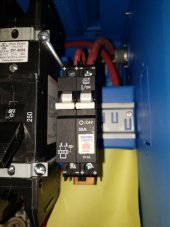To me, MidNite breakers (as are all of their other products), are the real deal.
Anything that needs an NRTL cert, gets it, usually by ETL.
The pics of breakers in this conversation, show the ETL logo, and file number (generally).
From the MidNite Solar site for these breakers,
"MidNite's breakers are rated to break the full rated load at the rated voltage repeatedly, with NO DAMAGE. Always use a properly sized breaker for disconnecting.
MNEPV breakers are the same as CBI QY breakers except the standard used is inadequate for the solar industry. MidNite breakers have been evaluated by ETL to 300VDC and are listed for US and Canada. All of the NRTL listings still apply. Breakers ordered under the CBI part numbering system will not be listed for 300VDC and in many cases are not suitable for the solar industry".
I would feel uncomfortable using most "DC" breakers that I've seen from China. Just because there are so many different brand names, and often, they are very thin on specs (that I can read). The risk just seems too great, IMO.
AND, with MidNite there is a US phone number, with some real help, on the other end on the line.
MidNite Fan-person, POD.




